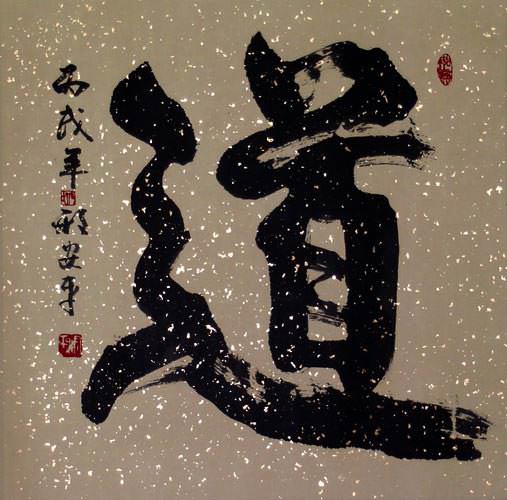The Lǎo Zǐ, Division 25:
There was something nebulous existing,
Born before Heaven and Earth.
Silent, empty,
It stands alone and does not change.
And undergoing no change
Goes round and does not weary,
Which may be called the mother of all under heaven.
I do not know its name,
And I give it the designation of the Dào.
And if I must name it, name it Vast.
Vast means it is passing beyond.
Passing beyond means it is gone far away.
To say it is far away is to say it is returning.
Therefore, the Dào is great;
Heaven is great;
Earth is great;
And the (sage) king is great.
In this realm there are four things that are great,
And the (sage) king is one of them.
Humans follow Earth.
Earth follows Heaven.
Heaven follows Dào.
The Dào follows self-becoming.
 Dào, as a thing, is most often translated into English as way[1]. Dào is just not a word, it is a sophisticated philosophical, religious, and cultural concept. That is why in this presentation of the Lǎo Zǐ herein, the word dào when used as a noun is not translated because dào is the Chinese concept. The purpose of this commentary, after all, is to acquire an understanding of what the Lǎo Zǐ is saying about about Dào.
Dào, as a thing, is most often translated into English as way[1]. Dào is just not a word, it is a sophisticated philosophical, religious, and cultural concept. That is why in this presentation of the Lǎo Zǐ herein, the word dào when used as a noun is not translated because dào is the Chinese concept. The purpose of this commentary, after all, is to acquire an understanding of what the Lǎo Zǐ is saying about about Dào.Dào when used as a noun, like the typical Chinese noun, can be singular or plural. So dào may refer to a collection of ways. Dào is also a verb, so one can be dào-ing. It is also a homonym, so way is just one meaning. So what follows is a short discussion of dào.
Dào as a noun. Some synonyms for dào are course, method, manner, mode, style, means, practice, fashion, and technique[2]. Chair Professor of Chinese Philosophy at Hong Kong University Chad Hansen explains that dào "is the answer to a 'how' or 'what-to-do' question" that is "prescriptive or normative" as one speaks of "ways in advising someone"[3]. For Chinese, there are literally ways and different ways people do things – good things, bad things, any thing. In the Zhuāng Zǐ, Köng Zĭ (Confucius) says:
"Fishes breed and grow in the water; man develops in the Tâo. Growing in the water, the fishes cleave the pools, and their nourishment is supplied to them. Developing in the Tâo, men do nothing, and the enjoyment of their life is secured. Hence it is said, 'Fishes forget one another in the rivers and lakes; men forget one another in the arts of the Tâo.'" (Zhuāng Zǐ, Chapter 6)[4]Each Chinese system of beliefs has its own dào. The author or authors of the Lǎo Zǐ were very mindful of competing ideas of Köng Zĭ and so explicitly distinguished their notions of dào in several chapters of the Lǎo Zǐ from the dào articulated by Köng Zĭ's followers. The two approaches are starkly different and the implications of their thinking point to totally different approaches to living.
"Confucius and his followers wanted to change the world and be proactive in setting things straight. They wanted to tamper, orchestrate, plan, educate, develop, and propose solutions. Daoists take their hands off of life, and Confucians want their fingerprints on everything. Imagine this comparison. If the Daoist goal is to become like a piece of unhewn and natural wood, the goal of the Confucians is to become a carved sculpture. The Daoists put the piece before us just as it is found, and the Confucians polish it, shape it, and decorate it."[5]Nonetheless, the Lǎo Zǐ uses dào as a metaphor for road or path to guide one to a desired destination or salvation[6]. After all, the ideogram of dào is a person's head over a road[7]. Its etymology is "a man walking in the streets or a road"[8].
Dào as a verb. When dào is used as a verb, it is often translated as speak, tell, expressed, defined in words or stated[9]. Chad Hansen believes these translations are too narrow because dào is used normatively, i.e. it means to guide as in to recommend, advocate, acknowledge, endorse, or as an activity, giving guidance[10]. By not translating dào as a noun but leaving the translations of dào as a verb, my hope is that the prescriptive aspect of the Lǎo Zǐ catches on, so that the reader understands that he is being given instructions or direction.
FOOTNOTES
[1] Hansen, Chad, "Taoism", Stanford Encyclopedia of Philosophy (Winter 2008 Edition), Edward N. Zalta (editor).
[2] Ibid.
[3] Ibid.
[4] The Writings of Kwang-dze (Chuang-tse) translated by James Legge, Sacred Books of the East, Volume 39, Oxford University Press, 1891.
[5] Littlejohn, Ronnie, “Daoist Philosophy”, Internet Encyclopedia of Philosophy, Jeffery L. Richey (editor); James Fieser and Bradley Dowden (general editors). Accessed December 20, 2008.
[6] Hansen, Chad, "Taoism", Stanford Encyclopedia of Philosophy (Winter 2008 Edition), Edward N. Zalta (editor).
[7] Sears, Richard, "道 (dào)", Chinese Etymology. Accessed December 20, 2008.
[8] Ibid.
[9] Hansen, Chad, "Taoism", Stanford Encyclopedia of Philosophy (Winter 2008 Edition), Edward N. Zalta (editor).
[10] Ibid.
IMAGE CREDIT
Tao Calligraphy by Xing An-Ping
